Solana plunged to a 12-month low of $95.23 on April 7, marking a sharp decline amid broader market turbulence.
However, as the market embarked on a recovery this week, SOL has witnessed a rebound, with its price climbing as demand surges.
SOL Rebounds 17%, Eyes Further Gains
Since SOL began its current rally, its value has soared by 17%. At press time, the altcoin trades at $124.58, resting atop an ascending trend line.

This pattern emerges when the price of an asset consistently makes higher lows over a period of time. It represents an uptrend, indicating that SOL demand is gradually increasing, driving its prices higher. It suggests that the coin buyers are willing to pay more, and it serves as a support level during price corrections.
SOL’s recovery is further supported by its rising Relative Strength Index (RSI), indicating increasing buying interest. This momentum indicator is at 49.58 at press time, poised to break above the 50-neutral line.

The RSI indicator measures an asset’s overbought and oversold market conditions. It ranges between 0 and 100. Values above 70 suggest that the asset is overbought and due for a price decline, while values under 30 indicate that the asset is oversold and may witness a rebound.
At 49.50 and climbing, SOL’s RSI signals a steady shift in momentum from bearish to bullish. A rise above 50 would confirm increasing buying pressure and a potential for a sustained upward price movement.
Solana Bulls Eye $138
SOL’s ascending trend line forms a solid support floor below its price at $120.74. If demand soars and the bullish presence with the SOL spot markets strengthens, the coin could continue its rally and climb to $138.41.

However, if profit-taking commences, the support at $120.74 would be breached, and the SOL’s price could revisit $95.23.
The post Solana Shakes Off 12-Month Lows, Gaining Momentum for a $130 Rally appeared first on BeInCrypto.








